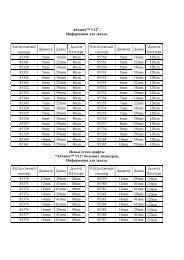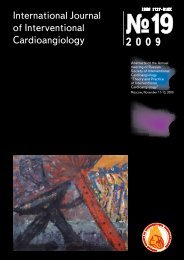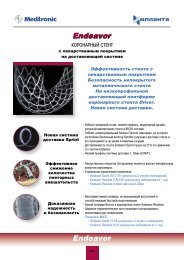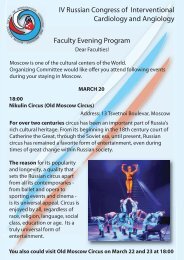International Journal of Interventional Cardioangiology
International Journal of Interventional Cardioangiology
International Journal of Interventional Cardioangiology
Create successful ePaper yourself
Turn your PDF publications into a flip-book with our unique Google optimized e-Paper software.
INTERVENTIONAL CARDIOLOGY<br />
one cannot exclude the natural process <strong>of</strong> progressing<br />
<strong>of</strong> coronary arterial lesions in some patients; this<br />
process could affect left ventricular function as a<br />
result <strong>of</strong> so called atherosclerotic cardiosclerosis.<br />
The increase <strong>of</strong> LV EF on the average from 56,5%<br />
to 62,4% (p < 0,05) was seen only in patients with<br />
good results <strong>of</strong> previous endovascular procedures<br />
and without signs <strong>of</strong> progressive stenotic-occlusive<br />
lesions <strong>of</strong> the coronary arteries by the moment <strong>of</strong><br />
control study (fig. 5).<br />
<br />
<br />
<br />
<br />
<br />
<br />
<br />
<br />
<br />
<br />
<br />
Figure 5. Dynamics <strong>of</strong> total LV EF in patients with good results <strong>of</strong><br />
previously performed PCIs and without signs <strong>of</strong> progressive<br />
coronary arterial lesions by the moment <strong>of</strong> control study.<br />
DATA OF SELECTIVE CORONARY<br />
ANGIOGRAPHY IN THE LONG-TERM PERIOD OF<br />
FOLLOW-UP<br />
In the long-term follow-up control coronary<br />
angiography was performed in 208 patients. As a<br />
result, the state <strong>of</strong> 258 stents was evaluated. The<br />
preservation <strong>of</strong> the optimal state <strong>of</strong> the stented segment<br />
for the whole follow-up duration was noted in<br />
176 (68,2%) cases, unsatisfactory results <strong>of</strong> the procedure<br />
were seen in 82 (31,8%) cases: restenosis ≥<br />
50% – in 72 (27,9%) and occlusion within the stent or<br />
in the stented segment <strong>of</strong> the coronary artery – in 10<br />
(3,9%) cases (fig. 6).<br />
<br />
<br />
<br />
<br />
<br />
<br />
<br />
<br />
<br />
<br />
<br />
<br />
<br />
On the average in 6 months after the procedure,<br />
that is, during the first control coronary angiographic<br />
examination, good results <strong>of</strong> stenting were seen in 184<br />
(71,3%) out <strong>of</strong> 258 cases. In 176 (95,7%) out <strong>of</strong> these<br />
cases angiographic results were preserved in the longterm,<br />
while in the remaining 8 (4,3%) cases restenosis<br />
≥ 50% was revealed. No cases <strong>of</strong> in-stent occlusion<br />
<br />
<br />
Figure 6. Angiographic results <strong>of</strong> coronary stenting in 5 years (on the<br />
<br />
average 64,3 months) after the procedure.<br />
(provided good six months’ results <strong>of</strong> stenting) were<br />
seen in the long-term follow-up.<br />
Unsatisfactory angiographic results <strong>of</strong> stenting at<br />
6 months were seen in 74 (28,7%) out <strong>of</strong> 258 cases:<br />
restenosis ≥ 50% - in 64 (24,8%) and in-stent occlusion<br />
– in 10 (3,9%) cases. Balloon angioplasty within<br />
the stent was performed in 64 cases with optimal<br />
immediate angiographic results, in the remaining 10<br />
cases in view <strong>of</strong> concomitant multiple coronary lesions<br />
and/or high risk <strong>of</strong> endovascular treatment surgical<br />
myocardial revascularization was recommended. In<br />
the long-term follow-up good angiographic results <strong>of</strong><br />
in-stent balloon angioplasty were seen in 60 (93,8%)<br />
cases, unsatisfactory results – in 4 (6,2%) cases: restenosis<br />
≥ 50% - in 2 (3,1%) and reocclusion in 2 (3,1%)<br />
cases.<br />
Thus, the preservation <strong>of</strong> good results <strong>of</strong> coronary<br />
stenting for 5 years was seen in the great majority <strong>of</strong><br />
patients (almost in 70% <strong>of</strong> cases). The rate <strong>of</strong> so called<br />
late restenosis (6 months and more after stenting) was<br />
less than 4,5%, the rate <strong>of</strong> repeated restenosis (in the<br />
site <strong>of</strong> in-stent balloon angioplasty) – 6,2% (including<br />
reocclusion rate – about 3% <strong>of</strong> cases).<br />
Hemodynamically significant de novo coronary<br />
lesions were seen in 83 (39,9%) patients. Herewith<br />
within the first 6 months progressive atherosclerotic<br />
lesions were revealed only in 2 (0,96%) patients, while<br />
in later periods – in 81 (38,9%). In 10 (4,8%) cases a<br />
newly formed > 50% stenosis <strong>of</strong> the left main coronary<br />
artery was found at control examination. It is worth<br />
noting that the patients in the group with progressive<br />
atherosclerotic lesions received hypolipidemic agents<br />
(statins), significantly less frequently that in the group<br />
without signs <strong>of</strong> progressive lesions – in 36% and<br />
81% <strong>of</strong> cases, respectively (р < 0,01). Meanwhile the<br />
number <strong>of</strong> patients with baseline dyslipidemia in these<br />
groups was similar<br />
Surgical myocardial revascularization was recommended<br />
to 24 (28,9%) out <strong>of</strong> 83 patients with newly<br />
formed hemodynamically significant coronary lesions,<br />
repeated endovascular interventions – to 46 (55,4%),<br />
and 13 (15,7%) patients (with distal coronary lesions,<br />
absence <strong>of</strong> clinical signs <strong>of</strong> angina or exertional angina<br />
<strong>of</strong> func. class I) received the recommendations for<br />
conservative therapy with mandatory prescription <strong>of</strong><br />
hypolipidemic agents.<br />
Repeated myocardialum revascularisation.<br />
During the follow-up period (on the average - 64,3<br />
months) repeated interventions had been recommended<br />
<br />
to 146 (51,6%) out <strong>of</strong> 283 patients: surgical<br />
myocardial revascularization – to 32 (11,3%) (in<br />
most cases for progressive lesions) and endovascular<br />
interventions – to 114 (40,3%) (in 68 cases<br />
for in-stent restenosis or reocclusion and in 46<br />
cases – for the lesions <strong>of</strong> native coronary arteries)<br />
(fig. 7).<br />
Within the first six months after stenting the main<br />
indication for repeated interventions was restenosis,<br />
after that – progressive atherosclerotic lesions <strong>of</strong><br />
native coronary arteries (fig. 8).<br />
Five-Year Results <strong>of</strong> Coronary Stenting in Patients with Different Forms <strong>of</strong> CAD<br />
25

















